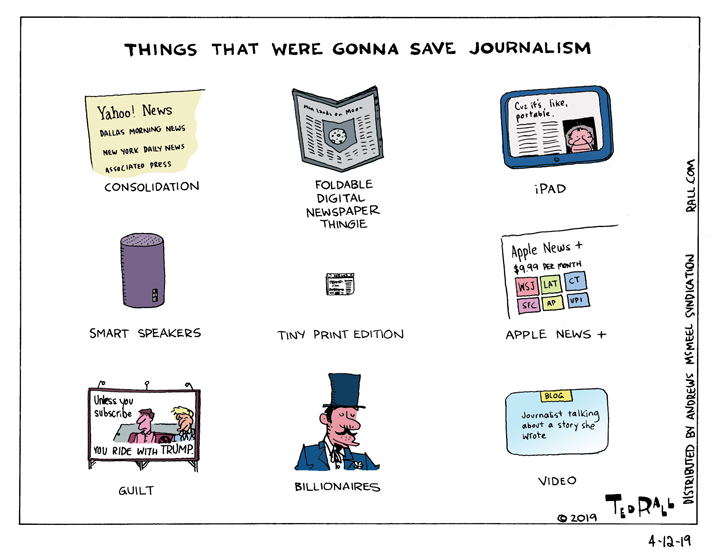
John Oliver recently dedicated his HBO show to why we need a federal anti-SLAPP law. Like most of his stuff, the episode was witty and engaging. It was also sloppy, thoughtless and poorly researched. From now on, I’ll wonder whether I can trust anything he says.
An anti-SLAPP motion is a powerful legal maneuver available to defendants against libel and defamation lawsuits. In the 27 states that have them, the filing of an anti-SLAPP motion brings everything to a halt until a judge — not a jury — decides various issues about a case. Does it involve a matter of public interest? Is there a chance the case would succeed at trial? If the judge rules for the defense, the case is thrown out and the plaintiff pays the defendant’s legal fees.
Liberals and conservatives alike like anti-SLAPP. Supporters say they protect activists, whistleblowers and average individuals from being bankrupted if they get sued by deep-pocketed corporations and wealthy individuals who use the courts to harass their victims. In his show Oliver described his experience being sued by a coal baron who wanted to chill criticism. HBO, Oliver said, spent $200,000 to defend him because the suit was filed in a state without anti-SLAPP.
It’s easy to see why someone like Oliver, targeted by a frivolous defamation claim designed to tie him up in court and waste his employer’s lucre, would yearn for a federal anti-SLAPP law. His must have been a frustrating experience.
There is, however, an inherent design flaw in anti-SLAPP: the United States Constitution. Under the equal protection clause, you can’t give rights to one class of defendant and not another. You can’t limit anti-SLAPP protections to impecunious individuals and small businesses; rich people and giant corporations have to get the same legal prerogatives.
Which is what has been happening. Billionaires and corporate conglomerates use anti-SLAPP to crush legitimate libel and defamation lawsuits filed by ordinary individuals and whistleblowers. Happens a lot. Why don’t you hear about these cases? Because media companies love, love, love anti-SLAPP.
In 2016 The National Enquirer published a cover story about fitness headlined: “Richard Simmons: He’s Now a Woman.” He wasn’t. “Secret Boob & Castration Surgery,” the tabloid screamed, “Yes, This Photo Shoot Is Real!” It wasn’t. The cover photo of “transwoman” Simmons was Photoshopped.
Thanks to anti-SLAPP, what should have been an open-and-shut defamation case turned a travesty of justice into a farce. While acknowledging that the paper lied about Simmons, Los Angeles judge said that letting Simmons’ case go forward was tantamount to saying that it is bad to be trans. Simmons was an innocent victim and the Enquirer knowingly lied. Yet the court ordered him to pay American Media, owner of the paper, $130,000 in legal fees. So much for anti-SLAPP as being a tool for the little guy! AMI brought in $310 million in revenues last year.
In 2018 MSNBC host Joy Reid [disclosure: I have appeared on Reid’s show] retweeted a photo of a Trump supporter yelling at a high school student at a Simi Valley, California city council meeting. Reid added the following text: “He showed up to rally to defend immigrants…She showed up too, in her MAGA hat, and screamed, ‘You are going to be the first deported’…’dirty Mexican!’ He is 14 years old. She is an adult. Make the picture black and white and it could be the 1950s and the desegregation of a school. Hate is real, y’all. It hasn’t even really gone away.”
Hate is real. The story was not. The kid said that Roslyn La Liberte, the woman in the photo, was trying to keep things “civil.” She never said that stuff.
La Liberte’s son emailed to inform Reid of the truth. Reid nevertheless reposted the image, this time alongside a black-and-white image of pro-segregation protesters in Little Rock in 1957 with this caption: “It was inevitable that this image would be made. It’s also easy to look at old black and white photos and think: I can’t believe that person screaming at a child, with their face twisted in rage, is real. B[ut] everyone one of them were. History sometimes repeats. And it is full of rage.”
La Liberte was wronged. Rather than settle or plead guilty, MSNBC’s lawyers hit the working grandmother with an anti-SLAPP motion. Ignoring the fact that Reid’s posts easily qualify under as “reckless disregard for the truth” under the landmark libel case Sullivan v. New York Times (1964), the judge wallowed in pro-corporate sophistry: “the juxtaposition of the photographs does not ‘make clear that [La Liberte] is alleged to have engaged in specific racist conduct akin to that demonstrated during desegregation.’” La Liberte’s case was thrown out, denying her justice. Adding injury to insult, she has to pay MSNBC’s legal fees. MSNBC is owned by NBC Universal, a $203 billion company.
President Trump used anti-SLAPP against Stormy Daniels, the porn actor who sued him for calling her a liar. Trump is worth $3 billion. Daniels owes him $293,000 for his legal fees.
My readers are familiar with my case against the Los Angeles Times. No one disputes the fact that they lied about me, fired me as a favor to the LAPD (which owned them at the time) and tried to destroy my journalistic reputation in order to send a chilling message to journalists who criticize the police. My anti-SLAPP case is still working its way through the court system—and things currently look good—but there is already a $330,000 judgment against me. They want me to pay that money to two billionaires, Dr. Patrick Soon-Shiong and LA schools superintendent and former Times publisher Austin Beutner, with a combined net worth of $16 billion.
Bill Cosby has been using the anti-SLAPP statute against his rape victims.
Faced with these cases, anti-SLAPP apologists sometimes say that the law isn’t bad, that it is simply being abused. If a law is written in such a way that it can be routinely abused, it is bad by definition.
(Ted Rall (Twitter: @tedrall), the political cartoonist, columnist and graphic novelist, is the author of “Francis: The People’s Pope.” You can support Ted’s hard-hitting political cartoons and columns and see his work first by sponsoring his work on Patreon.)





